19 November, 2000
Getting out of Town
We have been in McMurdo for nine days. Everything is ready to go. In fact
there isn't much to do. I've have been getting the urge to get away from the
station for a while. Yesterday I checked out a pair of cross-country skis. I
skied about three kilometers (2 mi) out on the sea ice to the runway. There
I saw all our gear bundled up and ready to go.
This morning Bob Hawley, Gary Clow, and I headed up the Hut Point Peninsula
on skis. Before going, we had to check out at the fire station where we were
given a radio to use in case of an emergency. We skied up about five
kilometers (3 mi) to a prominent volcanic feature called Castle Rock. Since
the weather was fairly clear, we had some great views. But we didn't stay
long because the temperature was -10C (14F) and the wind was fierce. It felt
great to get out away from town.
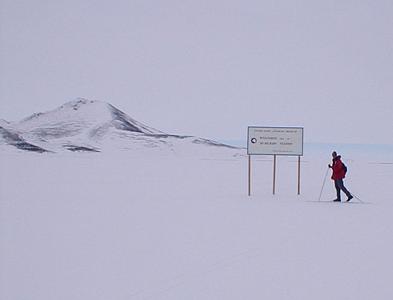
Skiing past the "Welcome to McMurdo Station" sign on the road out to the runway.
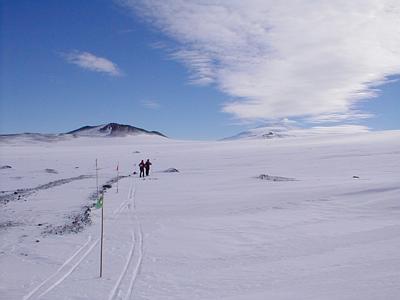
Ahead are Bob and Gary on our way up to Castle Rock. We are following a line of red and green flags which mark the safe route. The flagged route avoids parts of the glacier which may contain hidden crevasses.

McMurdo Station is situated on Hut Point at the tip of a volcanic peninsula that extends 20km (12mi) from the flanks of Mt. Erebus. Mt. Erebus is a 3794 meter (12,448ft) active volcano. A lava lake sits 215 meters (700ft) blow the rim of the summit crater.
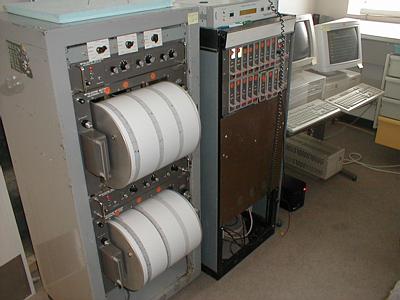
The Crary Lab houses the Mt. Erebus Volcanic Observatory where seismographs monitor earthquake activity on the mountain. The most recent eruption was in 1993 when rocks, smoke, and ash shot several thousand feet into the air. These seismographs recorded the 8.0 quake and subsequent 7.7 aftershock that stuck Papua New Guinea on November 16th.

Ahead are Bob and Gary on our way up to Castle Rock. We are following a line of red and green flags which mark the safe route. The flagged route avoids parts of the glacier which may contain hidden crevasses. In the distance is the steaming summit of Mt. Erebus.
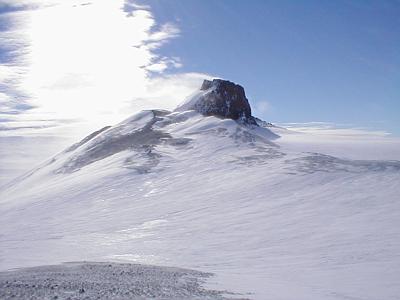
Castle Rock is a volcanic plug that formed during an eruption 1.2 million years ago. It is composed of rocks called hyaloclastites which indicates that the lava erupted under water. In this case the water was frozen in the form of the Ross Ice Shelf which may have been 400 meters (1300 ft) thicker than it is today.
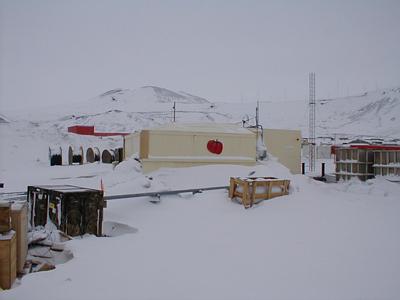
Up the hill from Mactown, situated among piles of construction materials, is a small building with a tomato painted on the side. This is the greenhouse. If you can't actually leave town, a visit to the greenhouse can be the next best thing.

Stepping inside the greenhouse is like entering another world. Unlike outside, it is warm and humid. Everything is bright and green. There is a strong scent of flowers and vegetables in the air.
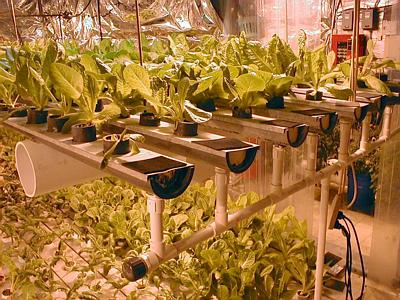
Vegetables such as lettuce, peppers, and tomatoes are grown here for the galley. It is done using hydroponics, without any soil. Plant roots sit in water containing the proper amounts of nutrients. Grow lights simulate day and night. To make this a wonderful escape from the frozen world outside, the greenhouse is equipped with a hammock, relaxing music, and even snacks for visitors who might want to stay awhile.
Contact the TEA in the field at
.
If you cannot connect through your browser, copy the
TEA's e-mail address in the "To:" line of
your favorite e-mail package.
|
